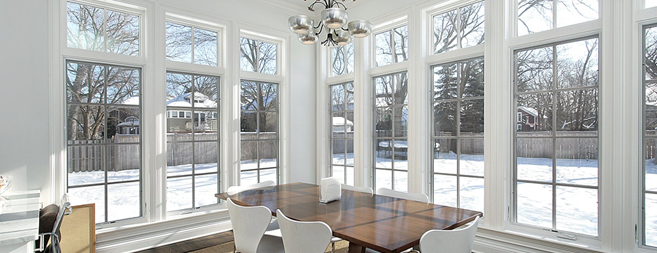Windows provide your home with light, warmth, and ventilation. They are essential to help create the character of the interior space. Lighting can make dramatic changes as the seasons change here in Connecticut. While offering a great view…they can also negatively impact a home's energy efficiency. You can reduce energy costs by installing energy-efficient windows in your home. If your budget is tight, energy efficiency improvements to existing windows can also help. Reduction in energy costs and potential for energy star rebates can be a great motivator to upgrade your windows.

If your home has very inefficient windows, it usually more cost-effective to replace them than to try to improve their energy efficiency. New, energy-efficient windows pay for themselves through lower heating and cooling costs.
Before selecting new windows for your home, determine what types of windows will work best and where to improve your home's energy efficiency. It's a good idea to install windows with the Energy Star seal. This seal ensures an established minimum energy performance rating criteria by climate. However, these criteria don't account for a home's design, such as window orientation or style.
Certain types of glazing can help reduce solar heat gain, lowering a window's SHGC. Low-e coatings are microscopically thin, virtually invisible metal or metallic oxide layers deposited directly on the surface of glass. Control heat transfer through windows with insulated glazing. Tinted glass absorbs a large fraction of incoming solar radiation through a window, reflective coatings reduce the transmission of solar radiation, and spectrally selective coatings filter out 40% to 70% of the heat normally transmitted through insulated window glass or glazing, while allowing the full amount of light to shine through.
If you're doing some major remodeling, you should also take advantage of the opportunity to incorporate your window design and selection as an integral part of your design to improve the energy efficiency of your home.
You'll find that you have several options to consider when selecting what type of windows you should use in your home.
Another important consideration is how the windows operate, because some operating types have less leakage than others. Traditional operating types include:
Awning. Hinged at the top and open outward. Because the sash closes by pressing against the frame, they generally have lower air leakage rates than sliding windows.
Casement. Hinged at the sides. Like awning windows, they generally have lower air leakage rates than sliding windows because the sash closes by pressing against the frame.
Fixed. Fixed panes that don't open. When installed properly they're airtight, but are not suitable in places where window ventilation is desired.
Hopper. Hinged at the bottom and open inward. Like both awning and casement, they generally have lower air leakage rates because the sash closes by pressing against the frame.
Single- and double-hung. Both sashes slide vertically in a double-hung window. Only the bottom sash slides upward in a single-hung window. These sliding windows generally have higher air leakage rates than projecting or hinged windows.
Single- and double-sliding. Both sashes slide horizontally in a double-sliding window. Only one sash slides in a single-sliding window. Like single- and double-hung windows, they generally have higher air leakage rates than projecting or hinged windows.
You can buy the best windows on the market but if they aren’t installed properly the efficiency can be lost. Windows should be installed according to the manufacturer’s recommendations and be proper sealed during installation to perform correctly. Give us a call for a free windows quote – get your home warmer for winter.

